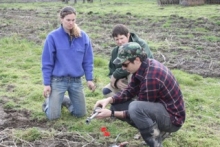PI Doug Collins taking bulk density samples with farmer cooperators Adam Brown and Haley Brown of Chinook Farm, Snohomish, WA
Increasing organic matter in soils is one way to build soil heath. Cover cropping, compost, and manure additions increase soil organic matter and improve the soil’s ability to hold and supply nutrients, water, and air to plants and animals. Soil organic matter provides a bank of nutrients, including nitrogen, that are made available to plants through a process called mineralization.
Knowing the chemical composition of cover crop residue and other organic materials can help predict nitrogen (N) mineralization from these materials over the course of a season. Fast, simple, and cheap methods to predict N mineralization are desirable for farmers, especially those who rely heavily on soil building practices such as cover cropping and manure for soil fertility. Certified organic farmers are encouraged to use these methods to build soil and are required to use only organic sources of nitrogen for fertility. Depending on N content of organic fertilizers and amendments, only small amounts of N may be made available in the year of application while the bulk is likely to contribute to the organic matter pool. Furthermore, soil properties across a single farm can be diverse, complicating generalizations and emphasizing the need for site-specific information.
In this study, N mineralization from plots with no applied fertilizer was estimated at 8 certified organic farms in western Washington State. While the study did not include enough farm sites or have sufficiently detailed plot histories to completely describe how previous management interacts with soil type to provide plant-available nitrogen from organic matter, it was found that most of the plots did mineralize sufficient nitrogen to produce marketable broccoli heads. Only three farms did not produce marketable head weights. These farms also yielded among the lowest nitrogen uptake and nitrogen mineralization. Several participating farmers commented that they were surprised to see how well their broccoli grew in the zero nitrogen plots without additional fertilizer. They also noted that adjacent broccoli plants that had been fertilized did not grow any better than the unfertilized plants.
Determining how much fertilizer to apply is a delicate process; too much fertilizer is a potential waste of money and can lead to nutrient loss while too little fertilizer will not optimize yield. Experimenting with zero-N plots on the farm is one way to accurately estimate nitrogen mineralization potential from organic matter. A fall nitrate test is another method to gauge the efficiency of fertilizer applications.

